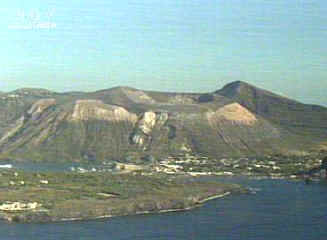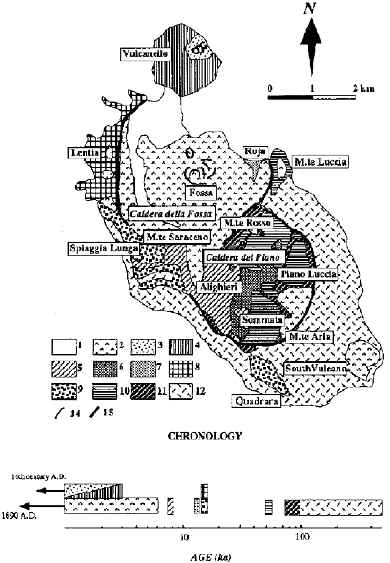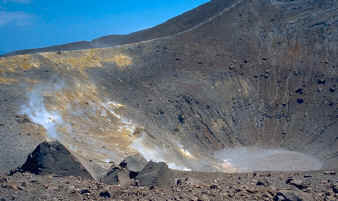| Vulcano,
the ancient HierÓ (sacred), Thermessa or Terasia; is a most interesting
island due to its volcanic and post-volcanic phenomena. The peculiar
characteristic of Vulcano is its plateau, the most vast of the Aeolian
islands, formed by lava, banks of tuff and quaternary deposits and
furrowed by deep valleys. It is surrounded by undulating and bare hills,
which fall towards the sea. On the high slopes of the island the panorama
is picturesque and wild: dykes alternate with extensive areas of tuff and
sand. The circular tour of Vulcano is a succession of fantastic visions
famous for their variety and beauty of scenery. |

|
|

Geological sketch map of
Vulcano island, from Ventura (1994).
- 1=alluvium and
beach deposits
- 2=pyroclastics
and lavas of the Fossa cone
- 3=Vulcanello
pyroclastics
- 4=Vulcanello
lava platform
- 5=Alighieri
pyroclastics and Monte Saraceno lavas
- 6=ash flow
deposits
- 7=Punta Roja
lava flow
- 8=lavas of the
Lentia volcanic complex
- 9=Spiaggia
Lunga and Quadrara pyroclastics
- 10=lavas and
pyroclastics of Monte Luccia, Piano Luccia, Monte Rosso and Sommata
- 11=oldest
products of Caldera del Piano filling (lavas and pyroclastics)
- 12=South
Vulcano lavas and pyroclastics
- 13=craters
- 14=Caldera del
Piano and Caldera della Fossa rims
|
The
island of Vulcano is formed by three morphological units: the first, to
the South is made of several stratum volcanoes - Mount Aria (500 m), Mount
Saraceno (481 m) and Mount Luccia (l88 m)- and of the great horseshoe
shaped depression gaping to the North-West of Vulcano Piano (330 m); the
second in the middle, is constituted by the Caldera of Vulcano, whose
central part makes up the Vulcano Fossa. This is deeply cut and is formed
by two craters: the Fossa I and 400 m South West from the first, the
present crater Fossa II; it has a diameter of about 500 m, a depth of 200
m and gave way to historically known eruptions, characterized by a mainly
explosive activity and by numerous lava flows, one of which, the famous
obsidian outflow of Pietre Nere expands along the North-West side in
proximity of
the two temporary craters of higher and lower Forgia Vecchia. The third
unit is made up by Vulcanello (123 m) with its three in line craters in
direction North-East South-West. This small apparatus ejected several lava
outflows which made up the plateau of Vulcanello and Punta del Roveto.
Vulcanello is connected to Vulcano by a thin isthmus, about one metre
above sea level - submerged by the sea under particularly adverse weather
conditions. The main apparatuses of Vulcano (Monte Saraceno, the Fossa,
Forgia Vecchia, the Faraglione and Vulcanello) are in line along a fault
in direction North-South. The eruptive activity of the Fossa crater was
intense, with more or less long intervals, until the beginning of the
historical age; Tucidide,
towards the end of the 5C BC supplies us with the first information.During
the second half of the 4C BC it seems that this volcano has given rise to
violent explosive action and during the succeeding centuries we have news
of numerous eruptions. Eruptive activities, with character of explosions,
took place in 43 A.D. and afterwards in 1444, 1550, 1626, 1727-1739,
1771-1786, 1812-1831, 1873-1879 and 1886-1890. In 1771 there was an
intense activity during which there was ejected the riolitic obsidian
outflow called Pietre Cotte, which can be seen on the North Western side.
The most recent period of activity began on the 3rd August 1888 and ended
on 22nd march 1890. During this eruptive phase there was an ejection of
antique and contemporary material of large dimensions and the launching of
projectiles which were called "bread-crust" bombs. From
that time Vulcano has remained in a fumaroles phase which is limited to
the cone of the Fossa and to the interior of its crater. From 1913 to
1923, from the fumaroles of the external part of cone, there occurred four
abundant ejections of liquid sulphur. Near the large rocks of Porto di
Levante one encounters another fumaroles area, between the remains of an
ancient volcanic building, for the most part dismantled. In 1915 on the
contour of a lava outflow, at Lentia, other fumaroles were formed which
were only short-lived. |
| Also
in the three craters funnels of Vulcanello, up to last century, there
occurred a solfataric activity, today completely extinguished. In the
fumaroles area of Porto di Levante there are interesting phenomena. In
certain tracts the ground is covered by a silical-chalk stratum fractured
by small openings. At the point of insertion there arise small cones from
the top of which the gases escape with a strong hissing
sound. In
those parts there is an extensive swamp where the mud is often thrown on
high by the violently escaping gas. During Summertime the ground is
covered by a beautiful and variegated colour. It is due to efflorescence (fumaroles
sublimations) of ferrous and aluminium sulphate oozing from the ground.
These formations disappear with the rain. Around the rocks and in front of
the beach there occurs the typical phenomenon of the gurgling water caused
by underwater fumaroles. On the seabed one notices vast deposits of
colloidal sulphur in the form of thin flaky filaments which give to the
sea a milky aspect. The gas, bursting out, generates numerous bubbles on
the surface of the sea. The phenomenon can be seen very well from the
height of the rocks when the sea is calm. |
 |
|

|
At
the beginning of the last century, the Borbonic General Nunziante created
at Vulcano the industry for the extraction of sulphur and alums with an
efficient complex of roads and factories. During the second half of the
century, the Scotsman Stevenson bought the entire island and continued the
work of his predecessor on rational lines. A mule track penetrated into
the large crater chasm, where were also constructed huts in brickwork for
the workmen. The last formidable explosion destroyed everything. Near to
the port gushes a hot spring called Acqua di Bagno. The therapeutic power
of this water is considerable. In the tourist field Vulcano has assumed a
first class role.
Vulcanello (124 m), emerged from
the sea in 183 B.C. by an underwater eruption, forms a small peninsular
and comprises three craters established on an alternation of lava
pyroclastic products. In the Eastern part, due to the erosion of the
marine and atmospheric agents, one can see an interesting section showing
how a volcanic cone is composed: successions of outflows of lava and
strata of pyroclastic materials. |


